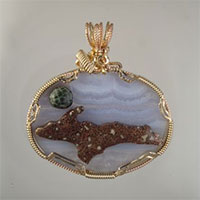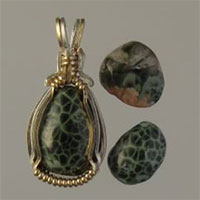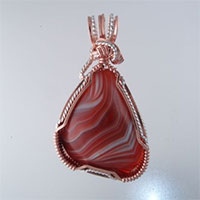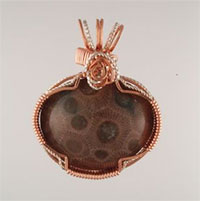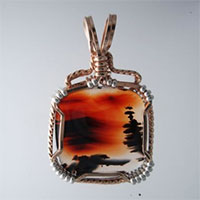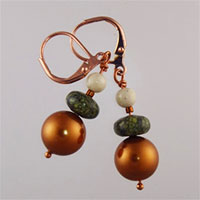For my first blog about past projects, I have to feature Beth’s Isle Royale Greenstone.
Beth’s husband John is a good buddy of mine and I have been mentoring him for a few years in wire artistry.John is now a superb wire-wrapper in his own right and could have easily wrapped this Greenstone if he had chosen to do so.
John had a HUGE Greenstone that he had found on Isle Royale in the early 1960’s. (Chlorastrolite or Greenstone did not become the Michigan state gem until March 30, 1973. Today collecting Greenstone on Isle Royale National Park is strictly prohibited.) The original Greenstone was approximately 3 ? inches by 2 inches. Considering the average Greenstone is half the size of a pea, this specimen was amazing. 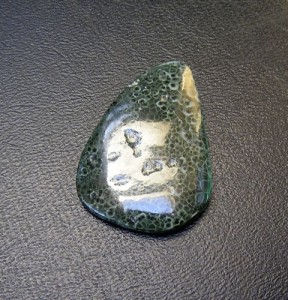 This Greenstone was larger than any I have seen anywhere, even at the Seaman Mineral Museum, which is considered to have the best collection of Michigan rocks and minerals in the world.
This Greenstone was larger than any I have seen anywhere, even at the Seaman Mineral Museum, which is considered to have the best collection of Michigan rocks and minerals in the world.
The rock was face polished in Houghton years ago, but by using Foredom and rushing the job the lapidarist ended up with divots in the stone and a poor polish.
John asked me to make a pendant for his wife, and my first response was, “Are you sure?” This, after all, was a great specimen. John had thought about it and was certain this was what he wanted to do. John did not have the lapidary equipment to cut and polish the stone properly, so that job was also mine.
I was concerned about cutting this stone, not unlike striking a diamond to split it. There is always a chance of ruination. Greenstones, especially large ones are not solid through and through. The Chlorastrolite often forms in a very thin layer and normally not in a clean pattern. Not many lapidarists can cut greenstone properly. There is a fine line between getting out the bad spots and going completely through the sometimes micro-thin pattern layer. I have cut several thousand greenstones myself, ruining a lot of them in the learning process, so I am well aware of the potential pitfalls. Cutting this beauty was a daunting and exciting task.
The process was pretty much routine until the final cutting and polishing, at which time the best prospect area was marked out for a pendant, and two other areas were marked for potential earrings.John had already suggested an area for the pendant that I agreed was correctly chosen.I roughed out the shape and started cutting on the Genie.I was amazed and pleased that the stone was so solid, having experienced soft Greenstones on numerous occasions.
Greenstones have to be worked on worn wheels to get the best results, so it takes a long time to work one up. This stone had the afore-mentioned divots that had to be meticulously worked out on the 600-grinding wheel with hopes that the Chlorastrolite layer would not be penetrated. Luck was again on my side as a small, classic, Greenstone pattern gradually presented itself. The finished stone turned out to be approximately 1? inches high and 1 inch wide.
John asked me to wrap this stone for Beth, and it was my honor to do so. I used 22Ga 14/20 GF. It is always my policy that the stone is the star in any wire wrap. I only wire to enhance the gem and not to do anything that distracts from the star. I think there are too many wire artists that get carried away in their own artistic abilities and over-wrap their gems. Why distract from a perfectly good gemstone? OK, I’ll get off my bandwagon for now, and get back to the story. I topped off the pendant by wiring Beth’s name on the reverse.
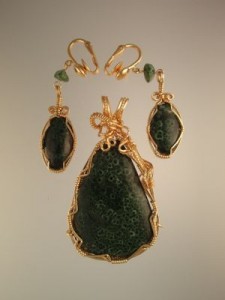
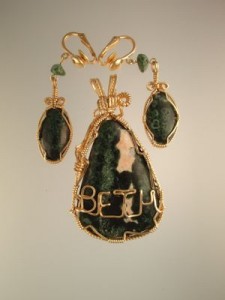
I thank John and Beth for allowing me the honor of making this glorious piece of jewelry.
Oh, by the way, I finished this whole project in one day. Sometimes I just can’t help myself!
Greenstones for your projects and wire-wrapped Greenstone pendants are available for your purchase.
Customer Review:
I thank you for an exceptional pendant. Don took a dark, unassuming specimen greenstone and turned it into a beautiful work of art. The stone has been sitting on a shelf for 40 or so years and now is a bright and beautiful necklace that I will enjoy wearing–I love it! With many thanks, Beth


